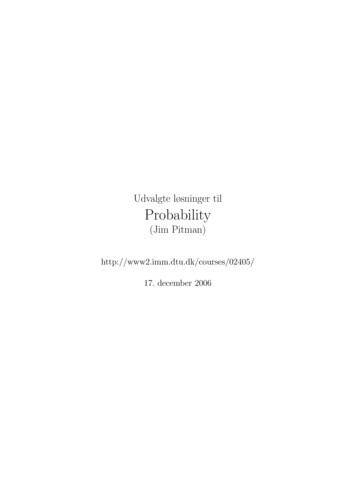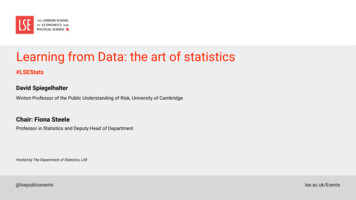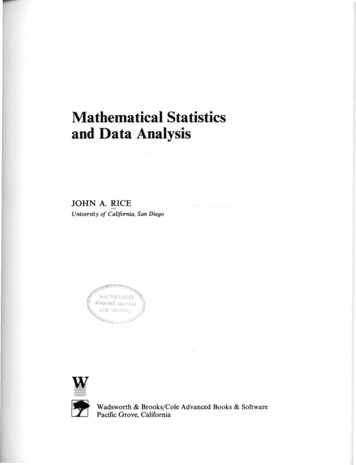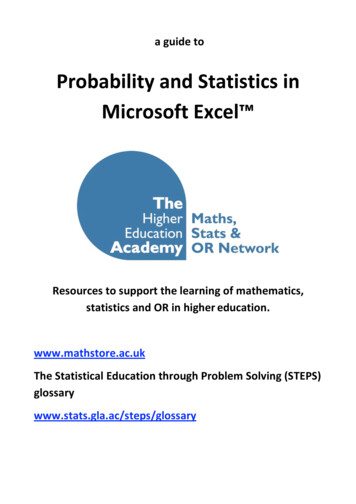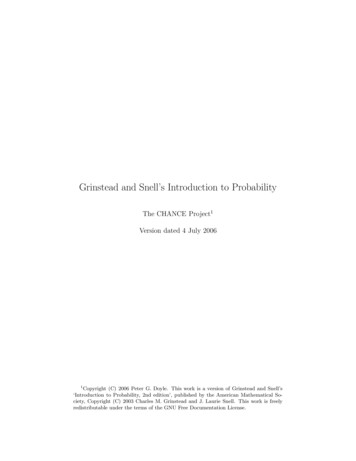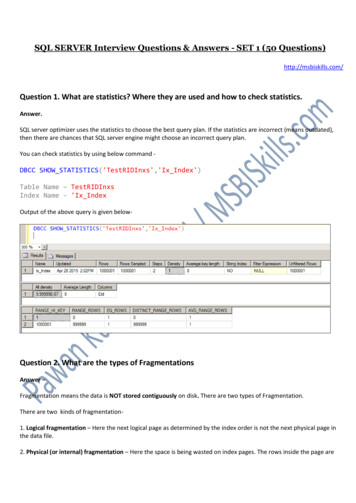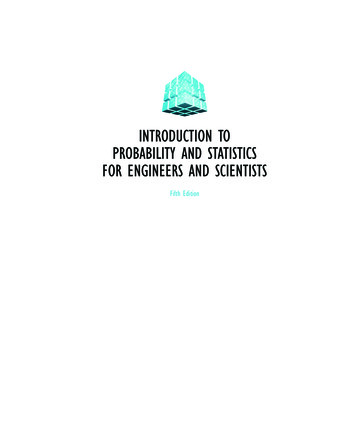
Transcription
INTRODUCTION TOPROBABILITY AND STATISTICSFOR ENGINEERS AND SCIENTISTSFifth Edition
INTRODUCTION TOPROBABILITY AND STATISTICSFOR ENGINEERS AND SCIENTISTS Fifth Edition Sheldon M. RossUniversity of Southern California, Los Angeles, USAAMSTERDAM BOSTON HEIDELBERG LONDONNEW YORK OXFORD PARIS SAN DIEGOSAN FRANCISCO SINGAPORE SYDNEY TOKYOAcademic Press is an imprint of Elsevier
Academic Press is an imprint of Elsevier32 Jamestown Road, London NW1 7BY, UK525 B Street, Suite 1800, San Diego, CA 92101-4495, USA225 Wyman Street, Waltham, MA 02451, USAThe Boulevard, Langford Lane, Kidlington, Oxford OX5 1GB, UKFifth Edition 2014Copyright 2014, 2009, 2004, 1999 Elsevier Inc. All rights reserved.No part of this publication may be reproduced or transmitted in any form or by any means, electronic or mechanical,including photocopying, recording, or any information storage and retrieval system, without permission in writing fromthe publisher. Details on how to seek permission, further information about the Publisher’s permissions policies and ourarrangements with organizations such as the Copyright Clearance Center and the Copyright Licensing Agency, can befound at our website: www.elsevier.com/permissions.This book and the individual contributions contained in it are protected under copyright by the Publisher (other thanas may be noted herein).NoticesKnowledge and best practice in this field are constantly changing. As new research and experience broaden ourunderstanding, changes in research methods or professional practices, may become necessary.Practitioners and researchers must always rely on their own experience and knowledge in evaluating and usingany information or methods described here in. In using such information or methods they should be mindful oftheir own safety and the safety of others, including parties for whom they have a professional responsibility.To the fullest extent of the law, neither the Publisher nor the authors, contributors, or editors, assume anyliability for any injury and/or damage to persons or property as a matter of products liability, negligence orotherwise, or from any use or operation of any methods, products, instructions, or ideas contained in thematerial herein.ISBN: 978-0-12-394811-3Library of Congress Cataloging-in-Publication DataRoss, Sheldon M.Introduction to probability and statistics for engineers and scientists / Sheldon M. Ross, Department of IndustrialEngineering and Operations Research, University of California, Berkeley. Fifth edition.pages cm.Includes index.ISBN 978-0-12-394811-31. Probabilities. 2. Mathematical statistics. I. Title.TA340.R67 2014519.5–dc232014011941British Library Cataloguing in Publication DataA catalogue record for this book is available from the British LibraryFor information on all Academic Press publicationsvisit our web site at store.elsevier.comPrinted and bound in the United States of America
ForElise
PrefaceThe fifth edition of this book continues to demonstrate how to apply probability theoryto gain insight into real, everyday statistical problems and situations. As in the previouseditions, carefully developed coverage of probability motivates probabilistic models ofreal phenomena and the statistical procedures that follow. This approach ultimatelyresults in an intuitive understanding of statistical procedures and strategies most oftenused by practicing engineers and scientists.Thisbookhasbeenwrittenfor anintroductory course in statisticsor inprobability andstatistics for students in engineering, computer science, mathematics, statistics, and thenatural sciences. As such it assumes knowledge of elementary calculus.ORGANIZATION AND COVERAGEChapter 1 presents a brief introduction to statistics, presenting its two branches of descriptive and inferential statistics, and a short history of the subject and some of the peoplewhose early work provided a foundation for work done today.The subject matter of descriptive statistics is then considered in Chapter 2. Graphsand tables that describe a data set are presented in this chapter, as are quantities thatare used to summarize certain of the key properties of the data set.To be able to draw conclusions from data, it is necessary to have an understandingof the data’s origination. For instance, it is often assumed that the data constitute a“random sample” from some population. To understand exactly what this means andwhat its consequences are for relating properties of the sample data to properties of theentire population, it is necessary to have some understanding of probability, and thatis the subject of Chapter 3. This chapter introduces the idea of a probability experiment, explains the concept of the probability of an event, and presents the axioms ofprobability.Our study of probability is continued in Chapter 4, which deals with the importantconcepts of random variables and expectation, and in Chapter 5, which considers somespecial types of random variables that often occur in applications. Such random variablesas the binomial, Poisson, hypergeometric, normal, uniform, gamma, chi-square, t, andF are presented.xiii
xivPrefaceIn Chapter 6, we study the probability distribution of such sampling statistics as thesample mean and the sample variance. We show how to use a remarkable theoreticalresult of probability, known as the central limit theorem, to approximate the we presentthejointprobabilitydistributionof the sample mean and the sample variance in the important special case in which theunderlying data come from a normally distributed population.Chapter 7 shows how to use data to estimate parameters of interest. For instance, ascientist might be interested in determining the proportion of Midwestern lakes that areafflicted by acid rain. Two types of estimators are studied. The first of these estimatesthe quantity of interest with a single number (for instance, it might estimate that47 percent of Midwestern lakes suffer from acid rain), whereas the second providesan estimate in the form of an interval of values (for instance, it might estimate thatbetween 45 and 49 percent of lakes suffer from acid rain). These latter estimators alsotell us the “level of confidence” we can have in their validity. Thus, for instance, whereaswe can be pretty certain that the exact percentage of afflicted lakes is not 47, it mightvery well be that we can be, say, 95 percent confident that the actual percentage isbetween 45 and 49.Chapter 8 introduces the important topic of statistical hypothesis testing, which isconcerned with using data to test the plausibility of a specified hypothesis. For instance,such a test might reject the hypothesis that fewer than 44 percent of Midwestern lakes hmeasuresthedegreeofplausibilityof the hypothesis after the data have been observed, is introduced. A variety of hypothesistests concerning the parameters of both one and two normal populations are considered.Hypothesis tests concerning Bernoulli and Poisson parameters are also presented.Chapter 9 deals with the important topic of regression. Both simple linearregression — including such subtopics as regression to the mean, residual analysis, andweighted least squares — and multiple linear regression are considered.Chapter 10 introduces the analysis of variance. Both one-way and two-way (withand without the possibility of interaction) problems are considered.Chapter 11 is concerned with goodness of fit tests, which can be used to test whether aproposed model is consistent with data. In it we present the classical chi-square goodnessof fit test and apply it to test for independence in contingency tables. The final sectionof this chapter introduces the Kolmogorov–Smirnov procedure for testing whetherdata come from a specified continuous probability distribution.Chapter 12 deals with nonparametric hypothesis tests, which can be used when oneis unable to suppose that the underlying distribution has some specified parametricform (such as normal).Chapter 13 considers the subject matter of quality control, a key statistical technique in manufacturing and production processes. A variety of control charts, including not only the Shewhart control charts but also more sophisticated ones based onmoving averages and cumulative sums, are considered.Chapter 14 deals with problems related to life testing. In this chapter, the exponential, rather than the normal, distribution plays the key role.
PrefacexvIn Chapter 15, we consider the statistical inference techniques of bootstrap statistical methods and permutation tests. We first show how probabilities can be obtained bysimulation and then how to utilize simulation in these statistical inference approaches.The fifth edition contains a multitude of small changes designed to even furtherincrease the clarity of the text’s presentations and arguments. There are also manynew examples and problems. In addition, this edition includes new subsections on The Pareto Distribution (subsection 5.6.2)Prediction Intervals (subsection 7.3.2 )Dummy Variables for Categorical Data (subsection 9.10.2)Testing the Equality of Multiple Probability Distributions (subsection 12.4.2)SUPPLEMENTAL MATERIALSSolutions manual and software useful for solving text examples and problems are available at: textbooks.elsevier.com/web/Manuals.aspx?isbn 9780123948113.ACKNOWLEDGMENTSWe thank the following people for their helpful comments on material of the fifthedition: Gideon Weiss, Uniferisty of HaifaN. Balakrishnan, McMaster UniversityMark Brown, Columbia UniversityRohitha Goonatilake, Texas A and M UniversitySteve From, University of Nebraska at OmahaSubhash Kochar, Portland State Universityas well as all those reviewers who asked to remain anonymous.
Instructor’s Manual forINTRODUCTION TOPROBABILITY AND STATISTICSFOR ENGINEERS AND SCIENTISTSFifth EditionSheldon M. RossDepartment of Industrial Engineeringand Operations ResearchUniversity of California, BerkeleyAMSTERDAM BOSTON HEIDELBERG LONDONNEW YORK OXFORD PARIS SAN DIEGOSAN FRANCISCO SINGAPORE SYDNEY TOKYOAcademic Press is an imprint of Elsevier
Academic Press is an imprint of Elsevier32 Jamestown Road, London NW1 7BY, UK525 B Street, Suite 1800, San Diego, CA 92101-4495, USA225 Wyman Street, Waltham, MA 02451, USAThe Boulevard, Langford Lane, Kidlington, Oxford OX5 1GB, UKFifth Edition 2014c 2014, 2009, 2004, 1999 Elsevier Inc. All rights reserved.Copyright No part of this publication may be reproduced or transmitted in any form or by any means, electronic or mechanical,including photocopying, recording, or any information storage and retrieval system, without permission in writing fromthe publisher. Details on how to seek permission, further information about the Publisher’s permissions policies and ourarrangements with organizations such as the Copyright Clearance Center and the Copyright Licensing Agency, can befound at our website: www.elsevier.com/permissions.This book and the individual contributions contained in it are protected under copyright by the Publisher (other thanas may be noted herein).NoticesKnowledge and best practice in this field are constantly changing. As new research and experience broaden ourunderstanding, changes in research methods or professional practices, may become necessary.Practitioners and researchers must always rely on their own experience and knowledge in evaluating and usingany information or methods described here in. In using such information or methods they should be mindful oftheir own safety and the safety of others, including parties for whom they have a professional responsibility.To the fullest extent of the law, neither the Publisher nor the authors, contributors, or editors, assume anyliability for any injury and/or damage to persons or property as a matter of products liability, negligence orotherwise, or from any use or operation of any methods, products, instructions, or ideas contained in thematerial herein.Library of Congress Cataloging-in-Publication DataApplication submittedISBN 13: 978-0-12-802046-3For all information on all Elsevier Academic Press publicationsvisit our Web site at www.elsevierdirect.com
Table of ContentsChapter 1 . . . . . . . . . . . . . . . . . . . . . . . . . . . . . . . . . . . . . . . . . . .1Chapter 2 . . . . . . . . . . . . . . . . . . . . . . . . . . . . . . . . . . . . . . . . . . .2Chapter 3 . . . . . . . . . . . . . . . . . . . . . . . . . . . . . . . . . . . . . . . . . . .5Chapter 4 . . . . . . . . . . . . . . . . . . . . . . . . . . . . . . . . . . . . . . . . . . . 11Chapter 5 . . . . . . . . . . . . . . . . . . . . . . . . . . . . . . . . . . . . . . . . . . . 18Chapter 6 . . . . . . . . . . . . . . . . . . . . . . . . . . . . . . . . . . . . . . . . . . . 23Chapter 7 . . . . . . . . . . . . . . . . . . . . . . . . . . . . . . . . . . . . . . . . . . . 26Chapter 8 . . . . . . . . . . . . . . . . . . . . . . . . . . . . . . . . . . . . . . . . . . . 32Chapter 9 . . . . . . . . . . . . . . . . . . . . . . . . . . . . . . . . . . . . . . . . . . . 38Chapter 10 . . . . . . . . . . . . . . . . . . . . . . . . . . . . . . . . . . . . . . . . . . 42Chapter 11 . . . . . . . . . . . . . . . . . . . . . . . . . . . . . . . . . . . . . . . . . . 45Chapter 12 . . . . . . . . . . . . . . . . . . . . . . . . . . . . . . . . . . . . . . . . . . 46Chapter 13 . . . . . . . . . . . . . . . . . . . . . . . . . . . . . . . . . . . . . . . . . . 48Chapter 14 . . . . . . . . . . . . . . . . . . . . . . . . . . . . . . . . . . . . . . . . . . 50Chapter 15 . . . . . . . . . . . . . . . . . . . . . . . . . . . . . . . . . . . . . . . . . . 53
Chapter 11. Method (c) is probably best, with (e) being the second best.2. In 1936 only upper middle class and rich people had telephones. Almost all votershave telephones today.3. No, these people must have been prominent to have their obituaries in the Times;as a result they were probably less likely to have died young than a randomly chosenperson.4. Locations (i) and (ii) are clearly inappropriate; location (iii) is probably best.5. No, unless it believed that whether a person returned the survey was independent ofthat person’s salary; probably a dubious assumption.6. No, not without additional information as to the percentages of pedestrians that wearlight and that wear dark clothing at night.7. He is assuming that the death rates observed in the parishes mirror that of the entirecountry.8. 12,246/.02 612,3009. Use them to estimate, for each present age x, the quantity A(x), equal to the averageadditional lifetime of an individual presently aged x. Use this to calculate the averageamount that will be paid out in annuities to such a person and then charge that person1 a times that latter amount as a premium for the annuity. This will yield an averageprofit rate of a per annuity.10. 64 percent, 10 percent, and 48 percent.1
Chapter 22. 360/r degrees.6. (d)(e)(f )(g)3.1832 5.397. (c) 119.14(d) 44.5(e) 144.7858. Not necessarily. Suppose a town consists of n men and m women, and that a is theaverage of the weights of the men and b is the average of the weights of the women.Then na and mb are, respectively, the sums of the weights of the men and of thewomen. Hence, the average weight of all members of the town isna mb a p b (1 p)n mwhere p n/(n m) is the fraction of the town members that are men. Thus, incomparing two towns the result would depend not only on the average of the weightsof the men and women in the towns but also their sex proportions. For instance, iftown A had 10 men with an average weight of 200 and 20 women with an averageweight of 120, while town B had 20 men with an average weight of 180 and 10women with an average weight of 100, then the average weight of an adult in town21460A is 200 13 120 23 4403 whereas the average for town B is 180 3 100 3 3 .10. It implies nothing about the median salaries but it does imply that the average of thesalaries at company A is greater than the average of the salaries at company B.11. The sample mean is 110. The sample median is between 100 and 120. Nothing canbe said about the sample mode.12. (a) 40.904(d) 8, 48, 6413. (a) 15.808(b) 4.3952
Instructor’s Manual3 14. Since xi nx̄ and (n 1)s2 xi2 nx̄ 2 , we see that if x and y are the unknownvalues, then x y 213 andx 2 y2 5(104)2 64 1022 1002 1052 22,715Therefore,x 2 (213 x)2 22,715Solve this equation for x and then let y 213 x.15. No, since the average value for the whole country is a weighted average where theaverage wage per state should be weighted by the proportion of all workers whoreside in that state.19. (a) 44.8(b) 70.4520. 74, 85, 9221. (a) 84.9167(b) 928.6288(c) 57.5, 95.5, 113.525. (a)(b)(c)(d)(e).3496.35.1175no3700/55 67.3 percent26. (b) 3.72067(c) .1456728. Not if both sexes are represented. The weights of the women should be approximately normal as should be the weights of the men, but combined data is probablybimodal.30. Sample correlation coefficient is .483831. No, the association of good posture and back pain incidence does not by itself implythat good posture causes back pain. Indeed, although it does not establish the reverse(that back pain results in good posture) this seems a more likely possibility.32. One possibility is that new immigrants are attracted to higher paying states becauseof the higher pay.33. Sample correlation coefficient is .7429
4Instructor’s Manual34. If yi a bxi then yi ȳ b(xi x̄), implying that (xi x̄)(yi ȳ)bb 22 b (xi x̄)(yi ȳ)b235. If ui a bxi , vi c dyi then (xi x̄)(yi ȳ)(ui ū)(vi v̄) bdand (ui ū)2 b2 (xi x̄)2 ,Hence,ru,v (vi v̄)2 d 2 (yi ȳ)2bdrx,y bd 36. More likely, taller children tend to be older and that is why they had higher readingscores.37. Because there is a positive correlation does not mean that one is a cause of the other.There are many other potential factors. For instance, mothers that breast feed mightbe more likely to be members of higher income families than mothers that do notbreast feed.
Chapter 31. S {rr, rb, rg, br, bb, bg, gr, gb, gg} when done with replacement and S {rb, rg, br, bg, gr, gb} when done without replacement, where rb means, for instance,that the first marble is red and the second green.2. S {hhh, hht, hth, htt, thh, tht, tth, ttt}. The event {hhh, hht,hth, thh} correspondsto more heads than tails.3. (a) {7}, (b) {1, 3, 4, 5, 7}, (c) {3, 5, 7}, (d) {1, 3, 4, 5}, (e) {4, 6}, (f ) {1, 4}4. EF {(1, 2), (1, 4), (1, 6)}; E F {(1, 1), (1, 2), (1, 3), (1, 4), (1, 5), (1, 6), orany of the 15 possibilities where the first die is not 1 and the second die is odd whenthe first is even and even when the first is odd.}; FG {(1, 4)}; EF c {any of the15 possible outcomes where the first die is not 1 and the two dice are not either botheven or both odd}; EFG FG.5. (a) 24 16(b) {(1, 1, 0, 0), (1, 1, 0, 1), (1, 1, 1, 0), (1, 1, 1, 1), (0, 0, 1, 1), (0, 1, 1, 1),(1, 0, 1, 1)}(c) 22 46. (a) EF c G c(e) EFG(h) (EFG)c(b) EF c G(c) E F G(d) EF EG FG(f ) E c F c G c(g) E c F c E c G c F c G c(i) EF G c EF c G E c FG(j) S7. (a) S(b) 09. 1 EF c G c7 EF c G2 EF G c(c) E(d) EF3 E c F Gc4 EFG(e) F EG5 E c FG6 EcF cG10. Since E F it follows that F E E c F and since E and E c F are mutually exclusivewe have thatP(F ) P(E) P(E c F ) P(E)11. Write Ei as the union of mutually exclusive events as follows: Ei E1 E1c E2 E1c E2c E3 · · · E1cNow apply Axiom 3 and the results of Problem 10.12. 1 P(E F ) P(E) P(F ) P(EF )5cEn 1En
6Instructor’s Manual13. (i) Write E EF EF c and apply Axiom 3.(ii) P(E c F c ) P(E c ) p(E c F ) from part (i) 1 P(E) [P(F ) P(EF )]14. P(EF c E c F ) P(EF c ) P(E c F ) P(E) P(EF ) P(F ) P(EF ) from Problem 13(i)15. 84, 84, 21, 21, 12016. To select r items from a set of n is equivalent to choosing the set of n r unselectedelements. (n 1)!(n 1)!n 1n 117. r 1r(n r)!(r 1)! (n 1 r)!r! n rn!rn r(n r)!r! nn18. (a) 1/3 (b) 1/3 (c) 1/1519. Because the 253 events that persons i and j have the same birthday are not mutuallyexclusive.20. P(smaller of (A, B) C) P(smallest of the 3 is either A or B) 2/321. (a)P(A B) P(A B A)P(A) P(A B Ac )P(Ac ) 1 · P(A) P(B Ac )P(Ac ) .6 .1(.4) .64(b) Assuming that the events A and B are independent, P(B Ac ) P(B) andP(AB) P(A)P(B) .0622. Chebyshev’s inequality yields that at least 1 1/4 of the accountants have salariesbetween 90, 000 and 170, 000. Consequently, the probability that a randomlychosen accountant will have a salary in this range is at least 3/4. Because a salaryabove 160, 000 would exceed the sample mean by 1.5 sample standard deviation,1it follows from the one-sided Chebyshev inequality that at most 1 9/4 4/13of accountants exceed this salary. Hence, the probability that a randomly chosenaccountant will have a salary that exceeds this amount is at most 4/13.23.24. 1/2P(RR red side up) P(RR, red side up)P(red side up) P(RR)P(red side up RR)P(red side up) (1/3)(1) 2/31/2
Instructor’s Manual7P(FCS)P(CS).02 2/5 .05P(FCS)P(CS F ) P(F ).02 1/26 .52P(F CS) 25.24850054/50054(b) 252/50025236/50036(c) 248/50024826. (a)27. Let Di be the event that ratio i is defective.P(D2 D1 ) 28. (a)(b)(c)(d)(e)(f )29.P(D1 D2 )P(D1 ) P(D1 D2 A)P(A) P(D1 D2 B)P(B)P(D1 A)P(A) P(D1 B)(P(B) .052 (1/2) .012 (1/2) 13/300.05(1/2) .01(1/2)6·5·4 5/9631/6 because all orderings are equally likely.(5/9)(1/6) 5/5463 2166·5·4 203·2·120/216 5/54P(A) P(A W )P(W ) P(A W c )P(W c ) (.85)(.9) (.2)(.1) .785P(W c D) P(W c D)(.8)(.1) 16/43P(D).215
8Instructor’s Manual30. Let Ni be the event that i balls are colored red.P(N2 R1 R2 ) P(N2 R1 R2 )P(R1 R2 )P(R1 R2 N2 )P(N2 )P(R1 R2 N0 )P(N0 ) P(R1 R2 N1 )P(N1 ) P(R1 R2 N2 )P(N2 )1(1/4) 2/30 (1/4)(1/2) 1(1/4)P(R1 R2 R3 )P(R3 R1 R2 ) P(R1 R2 )0 (1/8)(1/2) 1(1/4) 5/6 3/8 P(D VR) 31.50/1000P(DVR) 5/59P(VR)590/100032. (a) 1/3 (b) 1/233. P{S in second S in first drawer} P{A}/P{S in first}P{S in first} P{S in first A}1/2 P{S in first B}1/2 1/2 1/2 1/2 3/4Thus probability is 1/2 3/4 2/3.34.P(E C)P(C)P(E C)P(C) P(E C c )P(C c )(.268)(.7) .8118(.268)(.7) (.145)(.3)P(C E) P(C E c ) P(E c C)P(C)P(E c C)P(C) P(E c C c )P(C c ) (.732)(.7) .6638(.732)(.7) (.865)(.3)35. (a) P{good O} P{good, O}/P{O} .2P{O good}/[P{O good}.2 P{O average}.5 P{O bad}.3] .2 .95/[.95 .2 .85 .5 .7 .3] 190/82536. (a) P{sum is 7 first is 4} P{(4, 3)}/P{first is 4} (b) Same argument as in (a).1/361/6 1/6 P{sum is 7}.37. (a) p5 [1 (1 p1 p2 )(1 p3 p4 )](b) Conditioning on whether or not circuit 3 closes yields the answerp3 [(1 (1 p1)(1 p2)][1 (1 p4)(1 p5 )] (1 p3)[1 (1 p1p4 )(1 p2p5 )]38. 1 P(at most 1 works) 1 Q1 Q2 Q3 Q4 P1 Q2 Q3 Q4 Q1 P2 Q3 Q4 Q1 Q2 P3 Q4 Q1 Q2 Q3 P4 ; where Q1 1 P1 .
Instructor’s Manual939. (a) 1/8 1/8 1/4(b) P(F L) P(F ) P(L) P(FL) 1/4 1/4 2/32 7/16(c) 6/32, since there are 6 outcomes that give the desired result.40. Let Ni be the event that outcome i never occurs. ThenP(N1 N2 ) .5n .8n .3nHence, the desired answer is 1 .5n .8n .3n41. Let W1 be the event that component 1 works. Then,P(W1 F ) P(W1 F )1/2P(F W1 )(1/2) nP(F )1 (1/2)1 (1/2)n42. 1: (a) 1/2 3/4 1/2 3/4 1/2 9/128(b) 1/2 3/4 1/2 3/4 1/2 9/128(c) 18/128(d) 1 P(resembles first or second) 1 [9/128 9/128 P(resembles both)] 110/1282: (a) 1/2 1/2 1/2 1/2 1/2 1/32(b) 1/32 (c) 1/16 (d) 1 2/32 15/1643. Prisoner A’s probability of being executed remains equal to 1/3 provided the jailer isequally likely to answer either B or C when A is the one to be executed. To see thissuppose that the jailer tells A that B is to be set free. ThenP A to be executed jailer says B P{A executed, B}/P{B}P{B A executed}1/3 P{B A exec.}1/3 P{B C exec.}1/3 1/6 (1/6 1/3) 1/344. Since brown is dominant over blue the fact that you have blue eyes means that bothyour parents have one brown and one blue gene. Thus the desired probability is 1/4.p345. (a) Call the desired probability pA . Then pA p3 (1 p)3(b) Conditioning on which team is ahead gives the resultpA (1 (1 p)4 ) (1 pA )(1 p4 )(c) Let W be the event that team that wins the first game also wins the series. Now,imagine that the teams continue to play even after the series winner is decided.Then the team that won the first game will be the winner of the series if andonly if that team wins at least 3 of the next 6 games played. (For if they do they
10Instructor’s Manualwould get to 4 wins before the other team, and if they did not then the otherteam would reach 4 wins first.) Hence,P(W ) 6 6i 3i(1/2)i (1/2)6 i 20 15 6 121 643246. Let 1 be the card of lowest value, 2 be the card of next higher value, and 3 be thecard of highest value.(a) 1/3, since the first card is equally likely to be any of the 3 cards.(b) You will accept the highest value card if the cards appear in any of the orderings;1, 3, 2 or 2, 3, 1 or 2, 1, 3Thus, with probability 3/6 you will accept the highest valued card.47. .2 .3 .5,.2 .3 (.2)(.3) .44,.2(.3)(.4) .024,048. Let C be the event that the woman has breast cancer. ThenP(C pos) P(C, pos)P(pos)P(pos C)P(C)P(pos C)P(C) P(pos C c )P(C c ).9(.02) .9(.02) .1(.98)18 116 49. Let C be the event that the household is from California and let O be the event thatit earns over 250, 000. ThenP(C O) 50.P(CO)P(O)P(O C)P(C)P(O C)P(C) P(O C c )P(C c ).063(.12) .2066.063(.12) .033(.88)P(A B) P(A B A)P(A) P(A B Ac )P(Ac ) P(A) P(B Ac )P(Ac ) .6 .1(.4) .6451. The only way in which it would not be smaller than the value on card C is for cardC to have the smallest of the 3 values, which is 1/3. Hence, the desired probabilityis 2/3.
Chapter 41. P1 5/10, P2 5/10 5/9 .2778, P3 5/10 4/9 5/8 .1389.P4 5/10 4/9 3/8 5/7 .0595, P5 5/10 4/9 3/8 2/7 5/6 .0198,P6 5/10 4/9 3/8 2/7 1/6 .0040, where Pi P(X i).2. n 2i, i 0, 1, . . . , n3. P{X 3 2i} P{i tails} Pi , where P0 1/8, P1 3/8, P2 3/8, P3 1/8.4. (b) 1 F (1/2) 3/4(c) F (4) F (2) 1/12 (d) lim F (3 h) 11/12(e) F (1) lim F (1 h) 2/3 1/2 1/6h 0h 05. (a) c(b) 41 30 x dx 1 c 4.8 344.4 x dx .8 .4 .3846. Note first that since f (x)dx 1, it follows that λ 1/100; therefore,150 1/2 e 3/2 .3834. Also, 100 f (x)dx 1 e 1 .6321.50 f (x)dx e01507. The probability that a given radio tube will last less than 150 hours is 0 f (x)dx 1 2/3 1/3. Therefore, the probability desired is 52 (1/3)2(2/3)3 .32928. Since the density must integrate to 1: c 2 and P{X 2} e 4 .0183.9. With p(i, j) P(N1 i, N2 j)p(1, 1) (3/5)(2/4) 3/10p(1, 2) (3/5)(2/4)(2/3) 2/10p(1, 3) (3/5)(2/4)(1/3) 1/10p(2, 1) (2/5)(3/4)(2/3) 2/10p(2, 2) (2/5)(3/4)(1/3) 1/10p(3, 1) (2/5)(1/4) 1/10p(i, j) 0otherwise10. (a) Show that the multiple integral of the joint density equals 1.(b)(c)220 f (x, y)dy 12x /7 6x/71 x130 0 f (x, y)dy dx 0 (6x /7 3x 3 /14)dx 15/56.11
12Instructor’s Manual11. P{M x} P{X1 x, X2 x, . . . , Xn x} n P{Xi x} x n .i 1Differentiation yields that the probability density function is nx n 1 , 0 x 1.12.13.(i) Integrate over all y to obtain fX (x) xe x(ii) Integrate the joint density over all x to obtain fY (y) e y (sincexe x dx 1).(iii) Yes since the joint density is equal to the product of the individual densities.(i)(ii)1x 2dyy0 2dx 2(1 x), 0 x 1. 2y, 0 y 1.(iii) No, since the product of the individual densities is not equal to the joint density.14. fX (x) k(x) 1(y)dy, and fY (y) 1(y) k(x)dx. Hence, since 1 f (x, y)dydx 1(y)dy 1(x)dx. we can write f (x, y) fX (x)fY (y) whichproves the result.15. Yes because only in Problem 12 does the joint density factor.16. (i) P(X Y a) f (x, y)dxdyx y afX (x)fY ( y)dxdy FX (a y)fY ( y)dyx a y(ii) P{X Y } fX (x)dx fY ( y)dy FX ( y)fY ( y)dy.x yfI (x)fR (y)dydxx 2 y a a 11a/x 2 0 0 a 017. P{W a} 3a 2a2/3 a21 a 6x(1 x)/x 4dxThe density is now obtained upon differentiation: 11/2fW (a) 3 3a 2a 6(1 x)/x 3dx 3(1 a1/2 )a19. (a) fY (y) 10 f(x, y)dx 2/7 3y/14, 0 y 2. Hence,fx y (x y) 12x 2 6xy,4 3y0 x 1.20. PX Y (x y) PX (x) is equivalent to PX ,Y (x, y)/PY (y) PX (x) which is the condition (3.8). The verification in (b) is similar.21. E[X ] 5/10 5/9 5/12 5/21 25/252 1/42 1.83322. E[X ] 0 by symmetry.
Instructor’s Manual1323. The expected score of a meteorologist who says that it will rain with probability p isE p [1 (1 p)2 ] (1 p )[1 p2 ]Differentiation yields thatdE 2p (1 p) 2p(1 p ).dpSetting the above equal to 0 yields that the maximal (since the second derivative isnegative) value is attained when p p .24. If the company charges c, thenE[profit] c ApTherefore, E[profit] .1A when c A(p .1).25. (a) E[X ], because the randomly chosen student is more likely to have been on abus carrying a large number of students than on one with a small number ofstudents.(b) E[X ] 40(40/148) 33(33/148) 25(25/148) 50(50/148) 39.28E[Y ] (40 33 25 50)/4 3726. Let X denote the number of games played.E[X ] 2[p2 (1 p)2 ] 3[2p(1 p)] 2 2p(1 p)Differentiating this and setting the result to 0 gives that the maximizing value of p issuch that2 4p27. Since f is a density it integrates to 1 and so a b/3 1. In addition 3/5 E[X ] 120 x(a bx )dx a/2 b/4. Hence, a 3/5 and b 6/5.28. E[X ] α 2x 2 e αx dx
Introduction to probability and statistics for engineersand scientists / Sheldon M. Ross, Departmentof Industrial Engineering and OperationsResearch, University of California, Berkeley.Fifth edition. pagescm. Includes index. ISBN 978-0-12-394811-3 1. Probabilities. 2. Mathematical statistics

